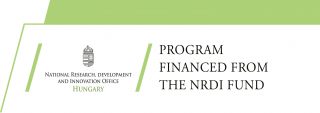Project number: 2019-1.1.1-PIACI-KFI-2019-00118
Total budget:199 884 000 Ft
Funding rate: 100%
Start of project implementation: 2020.01.01.
Expected completion of the project: 2022.12.31.
Project summary:
Project leader at the university is Dr. Habil. Ákos Jerzsele PhD Deputy Rector for Science and Research, Associate Professor
The aim of the call for proposals launched by the National Research, Development and Innovation Office (hereinafter referred to as the NRDI Office) from the National Research, Development and Innovation Fund (hereinafter referred to as the NRDI Fund) is to improve the competitiveness of enterprises by supporting their market-oriented research, development and innovation projects.
Our University is participating in the project as a consortium partner alongside Inno-Water Research and Environmental Services Ltd. and DAKÖV Dabas and Környéke Vízügyi Kft. From the HUF 816,157,871 grant, our university can spend HUF 199,884,000 on the professional work, in which the staff of the Department of Pharmacy and Toxicology, the Department of Chemistry, the Department of Animal Hygiene and Animal Health and the Üllői Tangazdaság participate.
Laboratory study of xenobiotic removal using adsorbents:
The laboratory testing of the effectiveness of specific adsorbents using mass spectroscopy methods is the responsibility of the SAI. The starting media range from “artificial” solutions containing xenobiotics in known concentrations, to crude acid, to treated wastewater. The main objective is to determine the adsorption capacity of the test substance for several adsorbents. An important task is the processing of the samples and the thorough sample preparation for subsequent analytical tests, taking into account the appropriate disease control measures. After proper sample preparation, the measurements are performed with a SCIEX QTRAP® 4500 mass spectrometer coupled to a Sciex ExionLC AD UHPLC, which is able to detect the picogram quantity of the compounds to be tested. Measurements are performed from solutions before and after adsorption to determine the adsorption capacity at a given time and temperature.
Investigation of the synthesis of different adsorbents in a substrate:
The process of this phase is very similar to that described in the previous phase, but here the tests are carried out with adsorbents synthesized in hydrogels. In the present task, we will determine the adsorption capacity of a new type of substrate produced by the consortium leader for different predefined pollutants, which will be selected on the basis of the experience of our previous task and the adsorbents (selective and non-selective) synthesised in the substrate type. After appropriate sample preparation, the measurements will be analysed with a SCIEX QTRAP® 4500 mass spectrometer, also coupled to a Sciex ExionLC AD UHPLC.
“Semi-factory” study of adsorbent-containing hydrogels coated with bacterial biofilm:
In this controlled in-plant study, the bioreactor is tested on pig and poultry farms. This will be carried out at the Dóramajor livestock farm of the SAI. After 3-5 days of antibiotics (amoxicillin, enrofloxacin) the slurry will be fed into the mobile bioreactor lines. Multiple layouts with multiple adsorbent hydrogel systems will be investigated. The degree of adsorption of antibiotics in the different systems will be analysed. Furthermore, we investigate the ability of the bioreactor microorganisms to remove heavy metals. For this purpose, we will use LC-SC-ICP-MS (single cell ICP-MS), a unique technology for measuring intracellular (e.g. bacterial) levels of heavy metals. The results of these tests will allow us to determine whether bacteria embedded in biofilms on the surface of hydrogel can remove harmful metals from the slurry. This is of great importance especially for zinc oxide, which is widely used for the prevention of porcine coli enteritis, incorporated into technology in significant quantities.

